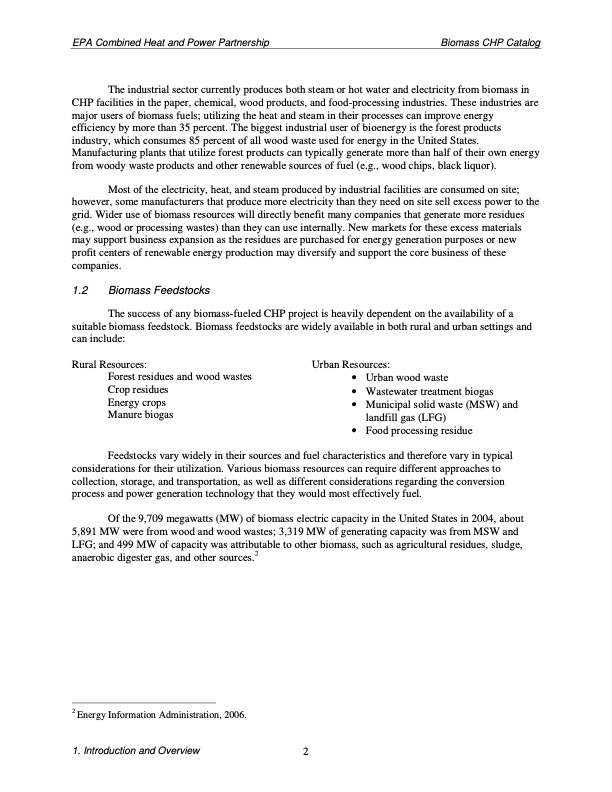
PDF Publication Title:
Text from PDF Page: 012
EPA Combined Heat and Power Partnership Biomass CHP Catalog The industrial sector currently produces both steam or hot water and electricity from biomass in CHP facilities in the paper, chemical, wood products, and food-processing industries. These industries are major users of biomass fuels; utilizing the heat and steam in their processes can improve energy efficiency by more than 35 percent. The biggest industrial user of bioenergy is the forest products industry, which consumes 85 percent of all wood waste used for energy in the United States. Manufacturing plants that utilize forest products can typically generate more than half of their own energy from woody waste products and other renewable sources of fuel (e.g., wood chips, black liquor). Most of the electricity, heat, and steam produced by industrial facilities are consumed on site; however, some manufacturers that produce more electricity than they need on site sell excess power to the grid. Wider use of biomass resources will directly benefit many companies that generate more residues (e.g., wood or processing wastes) than they can use internally. New markets for these excess materials may support business expansion as the residues are purchased for energy generation purposes or new profit centers of renewable energy production may diversify and support the core business of these companies. 1.2 Biomass Feedstocks The success of any biomass-fueled CHP project is heavily dependent on the availability of a suitable biomass feedstock. Biomass feedstocks are widely available in both rural and urban settings and can include: Rural Resources: Forest residues and wood wastes Crop residues Energy crops Manure biogas Urban Resources: • Urban wood waste • Wastewater treatment biogas • Municipal solid waste (MSW) and landfill gas (LFG) • Food processing residue Feedstocks vary widely in their sources and fuel characteristics and therefore vary in typical considerations for their utilization. Various biomass resources can require different approaches to collection, storage, and transportation, as well as different considerations regarding the conversion process and power generation technology that they would most effectively fuel. Of the 9,709 megawatts (MW) of biomass electric capacity in the United States in 2004, about 5,891 MW were from wood and wood wastes; 3,319 MW of generating capacity was from MSW and LFG; and 499 MW of capacity was attributable to other biomass, such as agricultural residues, sludge, anaerobic digester gas, and other sources.2 2 Energy Information Administration, 2006. 1. Introduction and Overview 2PDF Image | Biomass Combined Heat and Power Catalog of Technologies

PDF Search Title:
Biomass Combined Heat and Power Catalog of TechnologiesOriginal File Name Searched:
biomass_chp_catalog.pdfDIY PDF Search: Google It | Yahoo | Bing
NFT (Non Fungible Token): Buy our tech, design, development or system NFT and become part of our tech NFT network... More Info
IT XR Project Redstone NFT Available for Sale: NFT for high tech turbine design with one part 3D printed counter-rotating energy turbine. Be part of the future with this NFT. Can be bought and sold but only one design NFT exists. Royalties go to the developer (Infinity) to keep enhancing design and applications... More Info
Infinity Turbine IT XR Project Redstone Design: NFT for sale... NFT for high tech turbine design with one part 3D printed counter-rotating energy turbine. Includes all rights to this turbine design, including license for Fluid Handling Block I and II for the turbine assembly and housing. The NFT includes the blueprints (cad/cam), revenue streams, and all future development of the IT XR Project Redstone... More Info
Infinity Turbine ROT Radial Outflow Turbine 24 Design and Worldwide Rights: NFT for sale... NFT for the ROT 24 energy turbine. Be part of the future with this NFT. This design can be bought and sold but only one design NFT exists. You may manufacture the unit, or get the revenues from its sale from Infinity Turbine. Royalties go to the developer (Infinity) to keep enhancing design and applications... More Info
Infinity Supercritical CO2 10 Liter Extractor Design and Worldwide Rights: The Infinity Supercritical 10L CO2 extractor is for botanical oil extraction, which is rich in terpenes and can produce shelf ready full spectrum oil. With over 5 years of development, this industry leader mature extractor machine has been sold since 2015 and is part of many profitable businesses. The process can also be used for electrowinning, e-waste recycling, and lithium battery recycling, gold mining electronic wastes, precious metals. CO2 can also be used in a reverse fuel cell with nafion to make a gas-to-liquids fuel, such as methanol, ethanol and butanol or ethylene. Supercritical CO2 has also been used for treating nafion to make it more effective catalyst. This NFT is for the purchase of worldwide rights which includes the design. More Info
NFT (Non Fungible Token): Buy our tech, design, development or system NFT and become part of our tech NFT network... More Info
Infinity Turbine Products: Special for this month, any plans are $10,000 for complete Cad/Cam blueprints. License is for one build. Try before you buy a production license. May pay by Bitcoin or other Crypto. Products Page... More Info
| CONTACT TEL: 608-238-6001 Email: greg@infinityturbine.com | RSS | AMP |